My invited seminar at Università degli Studi di Milano – Segrate (November 16th 2017)
My invited seminar at Università degli Studi di Napoli Federico II (April 20th 2017)
My presentation at MMM2016, Dijon (October 11st 2016)
My presentation at STATPHYS26, Lyon (July 21st 2016)
My presentation at the MECO 41 Conference, Vienna (February 15th 2016)
Slides from a seminar at the Theoretical Physics department in Universitat de Barcelona (13th July 2015)
My 4-works poster at PUMPS2015 Barcelona (best poster prize)
My presentation at Viscous Liquids IV, Montpellier, (5th May 2015)
My poster at the Avalanches, Intermittency, and Nonlinear Response in Far-From-Equilibrium Solids program in KITP Santa Barabara, California (November 2014)
Parallel kinetic Monte Carlo simulation of Coulomb glasses
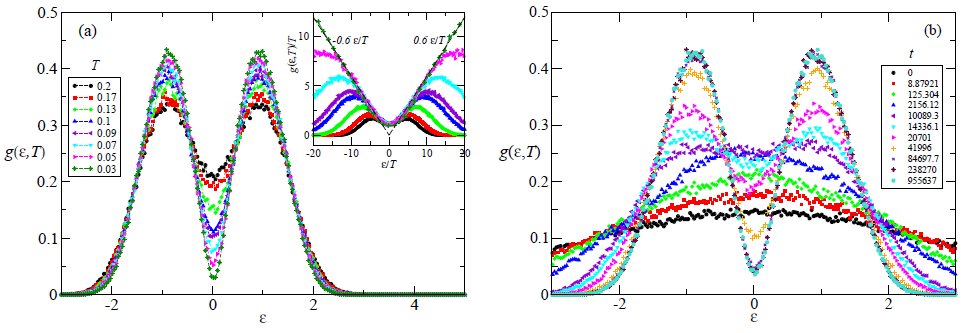
 , as function of temperature and time respectively. Data in (b) corresponds to
, as function of temperature and time respectively. Data in (b) corresponds to  .
.
 . The steady-state conductivity
. The steady-state conductivity  is reached after a transient time
is reached after a transient time  . Main figure: same data rescaled as a function of
. Main figure: same data rescaled as a function of  . (b) Fit to the Efros-Shklovskii law
. (b) Fit to the Efros-Shklovskii law ![Rendered by QuickLaTeX.com \sigma_0 = bT^{-\lambda} \exp[−(T_0/T)^{1/2}]](https://ezequielferrero.com/wp-content/ql-cache/quicklatex.com-e899fa56a32596f9956926a272250e55_l3.png) for
for  .
.
 . (b) Size dependence of the average update time of the
. (b) Size dependence of the average update time of the  local energies. The insets show the speedup of the GPU over the CPU implementation. While the speedup starts to saturate with L in (b), it is still strongly growing with
local energies. The insets show the speedup of the GPU over the CPU implementation. While the speedup starts to saturate with L in (b), it is still strongly growing with  in (a).
in (a).We develop a parallel rejection algorithm to tackle the problem of low acceptance in Monte Carlo methods, and apply it to the simulation of the hopping conduction in Coulomb glasses using Graphics Processing Units, for which we also parallelize the update of local energies. In two dimensions, our parallel code achieves speedups of up to two orders of magnitude in computing time over an equivalent serial code. We find numerical evidence of a scaling relation for the relaxation of the conductivity at different temperatures.
View full article…
Numerical approaches on driven elastic interfaces in random media
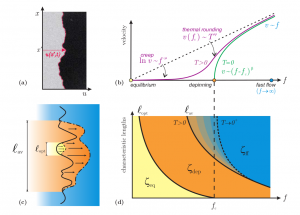
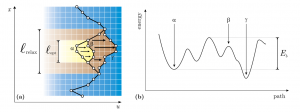
We present the main concepts behind the statistical and dynamical properties of elastic systems in disordered media, focused on the relation between the rough geometry and collective transport properties in driven steady-states. We review the numerical approaches that allow to analyze the equilibrium, creep, and depinning regimes of motion in these models.
View full article…
Nonsteady relaxation and critical exponents at the depinning transition
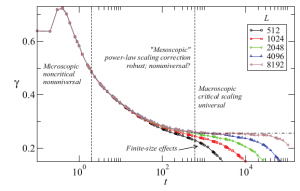
 showing finite size effects in the QEW line relaxation.
showing finite size effects in the QEW line relaxation.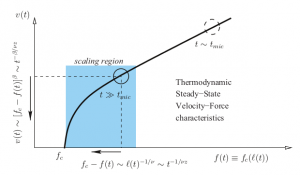
and the nonsteady universal relaxation at the thermodynamical critical
force

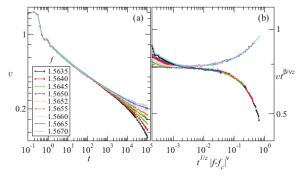
 .
.We study the nonsteady relaxation of a driven one-dimensional elastic interface at the depinning transition by extensive numerical simulations concurrently implemented on graphics processing units. Above a first, nonuniversal microscopic time regime, we find a nontrivial long crossover towards the nonsteady macroscopic critical regime. In order to avoid fitting effective exponents with a systematic bias we implement a practical criterion of consistency and perform large-scale (![]() ) simulations for the nonsteady dynamics of the continuum displacement quenched Edwards-Wilkinson equation, getting accurate and consistent depinning exponents for this class:
) simulations for the nonsteady dynamics of the continuum displacement quenched Edwards-Wilkinson equation, getting accurate and consistent depinning exponents for this class: ![]() ,
, ![]() ,
, ![]() , and
, and ![]() .
.
View full article…
 -state Potts model metastability study using optimized GPU-based Monte Carlo algorithms
-state Potts model metastability study using optimized GPU-based Monte Carlo algorithms

 -state Potts model first order phase transition. The two scenarios proposed by Binder.
-state Potts model first order phase transition. The two scenarios proposed by Binder.
 .
.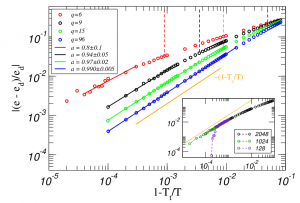

We implemented a GPU-based parallel code to perform Monte Carlo simulations of the two-dimensional ![]() -state Potts model. The possibility of performing high speed simulations at large enough system sizes allowed us to tackle an old standing question posed by k. Binder in 1981, regarding the existence or not of specific heat singularities at spinodal temperatures different of the transition one.
-state Potts model. The possibility of performing high speed simulations at large enough system sizes allowed us to tackle an old standing question posed by k. Binder in 1981, regarding the existence or not of specific heat singularities at spinodal temperatures different of the transition one.
View full article and our code…
Also find here our approach to the spinodal points in the ![]() -state Potts model.
-state Potts model.
Relaxation in the  -state Potts model
-state Potts model
We studied the nonequilibrium dynamics of the ![]() -state Potts model in the square lattice, after a quench to subcritical temperatures. By means of a continuous time Monte Carlo algorithm ͑nonconserved order parameter dynamics͒ we analyzed the long term behavior of the energy and relaxation time for a wide range of quench temperatures and system sizes. For
-state Potts model in the square lattice, after a quench to subcritical temperatures. By means of a continuous time Monte Carlo algorithm ͑nonconserved order parameter dynamics͒ we analyzed the long term behavior of the energy and relaxation time for a wide range of quench temperatures and system sizes. For ![]() we found the existence of different dynamical regimes, according to quench temperature range.
we found the existence of different dynamical regimes, according to quench temperature range.
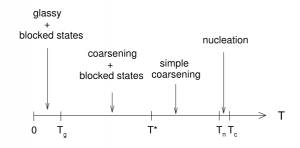
 -state Potts model with
-state Potts model with  , after a quench from infinite temperatures down to a subcritical temperature T.
, after a quench from infinite temperatures down to a subcritical temperature T.
 for
for 

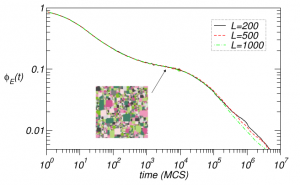
 ,
,  , and different values of L. The inset shows a typical configuration of the glassy state associated with the plateau.
, and different values of L. The inset shows a typical configuration of the glassy state associated with the plateau.View full article…and find here some related videos related to my PhD thesis.
Some slides of my PhD Thesis Presentation (in spanish)
Shortcode

























